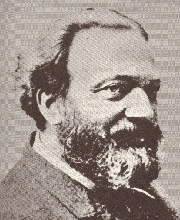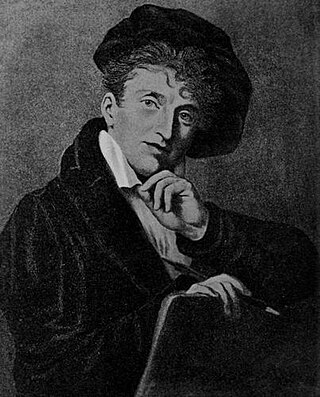Related Research Articles

Richard Ludwig Heinrich Avenarius was a German-Swiss philosopher. He formulated the radical positivist doctrine of "empirical criticism" or empirio-criticism.

A type foundry is a company that designs or distributes typefaces. Before digital typography, type foundries manufactured and sold metal and wood typefaces for hand typesetting, and matrices for line-casting machines like the Linotype and Monotype, for letterpress printers. Today's digital type foundries accumulate and distribute typefaces created by type designers, who may either be freelancers operating their own independent foundry, or employed by a foundry. Type foundries may also provide custom type design services.

Ludwig Heinrich Christian Geyer was a German actor, playwright, and painter.
VEB Typoart was the only type foundry of East Germany. It was a state-owned enterprise located in Dresden. The foundry's most influential art directors were Herbert Thannhäuser and Albert Kapr.
Hans Wagner may refer to:
Fundición Tipográfica Nacional or the Nacional Typefoundry was for many years the leading type foundry of Spain. It was founded in Madrid in 1915 and functioned there until bought out by Fundición Tipográfica Neufville of Barcelona in 1971. It employed prestigious designers like Carlos Winkow and Enric Crous-Vidal and was noted for its bold and striking art deco faces.
Carl Winckow known in Spain, where he spent most of his working life, as Carlos Winkow was a German type designer who worked primarily for the Nacional Typefoundry.

Imprenta y fundición tipográfica Richard Gans was a type foundry in business from 1888–1975. Founder, Richard Gans was the son of a doctor from Karlsbad, Austria who emigrated to Spain in 1874 where he founded the business in 1888. After his death in 1925 the foundry was led by Mauricio Wiesenthal until 1936. In the 1920s and 30s, Gans types were sold in the United States by Continental Type Founders Association.
Ludwig & Mayer was a German type foundry in Frankfurt am Main, Germany. Many important designers worked for the Ludwig and Mayer type foundry, including Heinrich Jost, Karlgeorg Hoefer, Helmut Matheis, and most notably Jakob Erbar, whose Erbar Book was one of the first geometric sans-serif typefaces, predating both Paul Renner's Futura and Rudolf Koch's Kabel by some five years. Starting in 1925, Ludwig & Mayer types were distributed in the United States by Continental Type Founders Association. When the foundry ceased operations in 1984, rights to the typefaces was transmitted to the Neufville Typefoundry.
Georg Belwe was a German type designer, typographer, graphic artist and teacher.

J.G. Schelter & Giesecke was a German type foundry and manufacturer of printing presses started 1819 in Leipzig by punchcutter Johann Schelter and typefounder Christian Friedrich Giesecke (1793-1850). The foundry was nationalized in 1946 by the new German Democratic Republic, forming VEB Typoart, Dresden.
C.E. Weber was a German type foundry established in 1827 in Stuttgart. Noted designers working for the foundry included Georg Trump, and Ernst Schneidler. The foundry closed in 1970; some designs passed to the Johannes Wagner Type Foundry, others to Stempel.
Johannes Wagner, Inh. was a type foundry created in 1921 by Johannes Wagner with his brother and brother-in-law in Berlin, moving to Ingolstadt in 1956. In the early 1980s the firm acquired many of the matrices of the Weber Typefoundry and most of those from Berthold. The company, by then named Letternservice Ingolstadt, closed in 2002, and its printing assets were moved to the printing museum in Leipzig.
Simoncini SA was a manufacturer of linecaster matrices established by Italian type designer Francesco Simoncini shortly after the Second World War. Simoncini had worked with the Ludwig & Mayer foundry before becoming the founder and managing director of his own firm in Bologna, Italy. In 1956, he was invited by Giulio Einaudi to design a new typeface for his publishing house. Einaudi wanted a new face based on Garamond, and the result was Simoncini Garamond, loosely based on the original. It was successfully used by Einaudi, and subsequently adopted by many other publishers. Another of his typefaces, Aster, is still very popular. He designed it in 1958, and originally intended it for use in newspapers and books. Simoncini died in 1967. Digital versions of his fonts are now available through Linotype.

Britannic is a sans-serif typeface family that was sold in metal type by Stephenson Blake. It is a "modulated" or stressed sans-serif design, in which the vertical lines are clearly thicker than the horizontals. The Klingspor Museum reports that it was originally created by the Wagner & Schmidt foundry of Leipzig, Germany. In design it is intended for headings, advertisements and signs rather than continuous body text. Stephenson Blake advertised it as "just the right note for an advertising or display panel".

Haas Type Foundry was a Swiss manufacturer of foundry type. First the factory was located in Basel, in the 1920s they relocated to Münchenstein.
Schriftguss AG was a type foundry in Germany founded in 1892 under the name Brüder Butter by purchasing the type casting firm of Otto Ludwig Bechert that had been founded in 1889. It was later incorporated in 1922 as Schriftguss A.-G. vorm. [prev.] Brüder Butter. Their types were known for “vigour, liveliness and freshness.” Though some faces were done in house, the foundry mainly worked with outside “Schriftkünstler”, more than was typical at the time. A unique product of the foundry were modular systems of “Plakattype” to compose shapes and letterforms for display and jobbing applications, for instance Dekora, or Albert Auspurg’s 1931 Ne-Po (negative–positive), and finally Super-Plakattype in 1949. After the Nazi seizure of power in 1933 the last of the Butter brothers resigned from the corporation and it was changed to a limited partnership. In 1948 the company was expropriated by the post-war communist government and became public property, under the name VEB Schriftguss Dresden, eventually becoming merged into VEB Typoart – Drucktypen, Matrizen, Messinglinien in 1951. As a state run enterprise, the foundry lost its verve and panache and settled into producing serviceable type without distinction.
Genzsch & Heyse was a German type foundry established in Hamburg. In the 1920s and 1930s, G+H types were sold in the United States by Continental Type Founders Association.

Normal-Grotesk is a sans-serif typeface that was sold by the Haas Type Foundry of Basel and Münchenstein, Switzerland, and popular in Swiss graphic design towards the end of the metal type period in the mid-twentieth century.
Arnold Drescher was trained as a teacher in Auerbach in 1896 and later studied at Dresden Academy of Fine Arts from 1905 to 1907 where he became a specialised instructor for art teachers, becoming a professor in 1920. As well as working freelance as a designer, he was also employed by the Staatliche Akademie für graphische Künste und Buchgewerbe. Between 1940 and 1945, he was the Academy's director. As well as being a typographer, he was a prolific painter and illustrator, designing posters for the East German government. In 1960 he retired to Braunschweig where he later died.
References
- ↑ "Typoart". elsner+flake typeshopping. 2011-11-22. Retrieved 2011-11-22.
- ↑ Jaspert, W. Pincus, W. Turner Berry and A.F. Johnson. The Encyclopedia of Type Faces. Blandford Press Lts.: 1953, 1983, ISBN 0-7137-1347-X, p. 2408-249